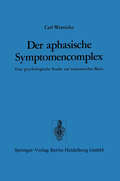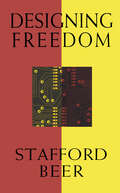- Table View
- List View
Das Verhalten von Metallklebungen bei Schlagbeanspruchung (Forschungsberichte des Landes Nordrhein-Westfalen #2390)
by Friedrich EichhornDeep-Sea Sediments: Physical and Mechanical Properties (Marine Science #2)
by Anton InderbitzenAs part of its continuing program to stimulate superior basic research in the marine environment, the Office of Naval Research, Ocean Science and Technology Division, sponsored a series of closed seminar-workshops in 1972-1973. Each seminar focused upon one re search area of marine geology which is relatively new and in need of a critical evaluation and accelerated support. The subjects areas chosen for the seminars were: 1. natural gases in marine sediments and their mode of distribution, 2. nephelometry and the optical properties of ocean waters, 3. physical and engineering properties of deep-sea sediments, and 4. physics of sound in marine sediments. The objectives of each seminar-workshop were to bring into sharper focus the state-of-the-science within each subject area, to effect some degree of coordination among the investigators working within each of these areas and to provide the Ocean Science and Technology Division guidance for national program support. This volume.contains most of the papers presented at the semi nar on the physical and engineering properties of deep-sea sediments. The seminar was held at Airlie House, Airlie, Virginia on April 24- 27, 1973 and was organized and chaired by A. Inderbitzen. The at tendees were invited from among the leading investigators in this field from both the engineering and scientific disciplines. Each attendee was requested to prepare a paper within his area of spe ciality.
Defects and Transport in Oxides (Battelle Institute Materials Science Colloquia)
by Robert JaffeeDEFECTS AND TRANSPORT IN OXIDES is the proceedings of the eighth Battelle Colloquium in the Materials Sciences, held in Columbus and Salt Fork, Ohio, September 17-22, 1973. It took as its theme the relationship between defects and transport of both mass and charge in oxides. Applications of defect-controlled transport to a number of important processes in oxides also were covered. In selecting this topic, the Organizing Committee thought that 1973 was timely to bring together the leading theoretical and experimental researchers in the oxide transport field to review its status in a critical way, and to consider current major research directions and how research in the future might be guided into fruitful areas. The meeting was highlighted by the presentation of several papers which suggest that major advances in our understanding of transport in oxides appear to be imminent. These papers dealt with the results of new theoretical approaches whereby the energies and configurations of defects may be calculated, and with new experimental techniques for indirectly observing these defects, previously thought to be below the limits of experimental resolving power. Other papers, dealing with the application of defect chemistry to technological processes, served to demonstrate the successes and to point out yet unresolved problems associated with ix x PREFACE understanding the chemistry of imperfect crystals.
The Defence of Western Europe: Papers Presented at the National Defence College, Latimer, in September, 1972 (pdf)
by John C. GarnettDer aktienrechtliche Abhängigkeitsbericht unter ökonomischen Aspekten: (pdf) (Bochumer Beiträge zur Unternehmensführung und Unternehmensforschung #15)
by Harald RichardtDer Brief des Kaufmanns: Lehr- und Übungsbuch für den kaufmännischen Schriftverkehr (pdf)
by Paul FeldkellerDer Dienstleistungsbetrieb: Wesen — Struktur — Bedeutung
by Ludwig BerekovenDie Anfänge meiner Beschäftigung mit dem Thema "Dienstleistungen" reichen bereits in die sechziger Jahre zurück; das positive Echo auf zwei Aufsätze ermutigte mich, eine umfassendere Darstellung in Angriff zu nehmen, nachdem eine Durchsicht der Literatur ergab, daß zu dieser Thematik eine grundlegende Arbeit fehlt. Natürlich bedeutet dies nicht, daß im betriebswirtschaftlichen Schrifttum die Vokabel "Dienst leistung" bzw. "Dienstleistungsbetriebe" bisher ausgeklammert war; in jeder all gemeinen Darstellung gibt es bekanntlich Versuche zur Klassifizierung der betrieblichen Erscheinungsformen, und natürlich existiert auch eine Fülle von Veröffentlichungen branchenspezifischen Inhalts, die vielfach aus der Praxis und für die Praxis geschrieben wurden. Ferner sei darauf hingewiesen, daß einzelne Dienstleistungssparten, wie etwa Transport und Verkehr, Fremdenverkehr usw. , Gegenstand spezieller Institutionen lehren wurden, die z. T. seit Jahrzehnten an den Hochschulen in Forschung und Lehre vertreten werden. Schließlich wird das Thema natürlich auch in den zahlreichen wissenschaftlichen Beiträgen zur Typologie der Einzelwirtsmaften berührt. Ohne den theoretischen Erkenntniswert bzw. die praktisme Bedeutung dieser Bemü hungen zu schmälern, darf dennom gesagt werden, daß das bisher Vorliegende da beginnt, wo diese Arbeit eigentlich endet; es fehlt m. a. W. bislang an der grund legenden Auseinandersetzung mit dem Wesen der Dienstleistung bzw. der Dienst leistungsbetriebe. Dadurm bleibt an der Basis bereits so vieles unklar, daß die darauf aufbauenden Einsichten und Folgerungen des logismen Gesamtzusammenhangs ent behren.
Der Einfluß der Austenitisierungs- und Abschreckbedingungen auf die Mengen- und Größenverteilung der Karbide bei gehärteten Werkzeugstählen (Forschungsberichte des Landes Nordrhein-Westfalen #2397)
by Helmut HuberDer Einfluß der Besteuerung auf die Gestaltung des Preisentscheidungsprozesses in der Unternehmung
by Frank TischerDer Einfluß der Betriebsgröße auf Kosten und Erlöse von Kreditinstituten (Schriftenreihe des Instituts für Kreditwesen der Westfälischen Wilhelms-Universität Münster #17)
by Henning Osthues-AlbrechtDer Einfluß der Spindelexzentrizität auf das Fadenbruchverhalten und die Graneigenschaften (Forschungsberichte des Landes Nordrhein-Westfalen #2417)
by Joachim LünenschloßDer Einfluß von Wind auf die Sicherheit im Straßenverkehr (Forschungsberichte des Landes Nordrhein-Westfalen #2446)
by Werner LeinsDer technische Fortschritt beim Produktionsprozeß: Ein dynamisches Modell für innovative Industrieunternehmen
by Peter MillingDer Verkaufspreis in der Industrie: Die Marketingpraxis für die Bestimmung der Preisobergrenze
by Heinz NagtegaalDesign of Experiments: A Realistic Approach
by Virgil L. Anderson Robert A. McLeanThe book is written for anyone who wants to design experiments, carry them out, and analyze the results. The authors provide a clear-cut, practical approach to designing experiments in any discipline and explain the general principles upon which such design is based. The reader then can apply these theories to any specific problem in his own work. No advanced mathematics is needed to utilize Design of Experiments – the necessary statistical concepts and briefly reviewed in the first two chapters. Subsequent chapters explain why and how the design of experiments in an intrinsic part of the scientific method, what problems will be encountered by the researcher in setting up his experiment and how to deal with them, and how to accurately analyze the result in terms of the sample taken and the method used. Each chapter includes problems encountered in specific fields so that the reader can test himself on his comprehension of the material. The diversity of the applications that these problems encompass also allows the reader to grasp the basic principles that unite the statistical approach to experiment design. Researchers and students in engineering, agriculture, pharmacy, veterinary science, chemistry, biology, the social; sciences, statistics, mathematics, or any other field that requires the design, solution, and analysis of problems will find this book absolutely indispensable.
Design of Experiments: A Realistic Approach
by Virgil L. Anderson Robert A. McLeanThe book is written for anyone who wants to design experiments, carry them out, and analyze the results. The authors provide a clear-cut, practical approach to designing experiments in any discipline and explain the general principles upon which such design is based. The reader then can apply these theories to any specific problem in his own work.No advanced mathematics is needed to utilize Design of Experiments – the necessary statistical concepts and briefly reviewed in the first two chapters. Subsequent chapters explain why and how the design of experiments in an intrinsic part of the scientific method, what problems will be encountered by the researcher in setting up his experiment and how to deal with them, and how to accurately analyze the result in terms of the sample taken and the method used. Each chapter includes problems encountered in specific fields so that the reader can test himself on his comprehension of the material. The diversity of the applications that these problems encompass also allows the reader to grasp the basic principles that unite the statistical approach to experiment design.Researchers and students in engineering, agriculture, pharmacy, veterinary science, chemistry, biology, the social; sciences, statistics, mathematics, or any other field that requires the design, solution, and analysis of problems will find this book absolutely indispensable.
Designing Freedom (The CBC Massey Lectures)
by Stafford BeerDistinguished cyberneticist Stafford Beer states the case for a new science of systems theory and cybernetics. His essays examine such issues as The Real Threat to All We Hold Most Dear, The Discarded Tools of Modern Man, A Liberty Machine in Prototype, Science in the Service of Man, The Future That Can Be Demanded Now, The Free Man in a Cybernetic World. Designing Freedom ponders the possibilities of liberty in a cybernetic world.
A Desirable World: Essays in Honor of Professor Bart Landheer
by A. M. C. H. Reigersman-Van Der Eerden G. ZoonDeterministic Threshold Models in the Theory of Epidemics (Lecture Notes in Biomathematics #1)
by P. WaltmanThese notes correspond to a set of lectures given at the Univer sity of Alberta during the spring semester, 1973. The first four sec tions present a systematic development of a deterministic, threshold model for the spraad of an infection. Section 5 presents some compu tational results and attempts to tie the model with other mathematics. In each of the last three sections a separate, specialized topic is presented. The author wishes to thank Professor F. Hoppensteadt for making available preprints of two of his papers and for reading and comment ing on a preliminary version of these notes. He also wishes to thank Professor J. Mosevich for providing the graphs in Section 5. The visit at the University of Alberta was a very pleasant one and the author wishes to express his appreciation to Professors S. Ghurye and J. Macki for the invitation to visit there. Finally, thanks are due to the very competent secretarial staff at the University of Alberta for typing the original draft of the lecture notes and to Mrs. Ada Burns of the University of Iowa for her excellent typescript of the final version. TABLE OF CONTENTS 1. A Simple Epidemic Model with Permanent Removal . . . • . . . 1 2. A More General Model and the Determination of the Intensity of an Epidemic. 10 21 3. A Threshold Model. 4. A Threshold Model with Temporary Immunity. 34 5. Some Special Cases and Some Numerical Examples 48 A Two Population Threshold Model . 62 6.























